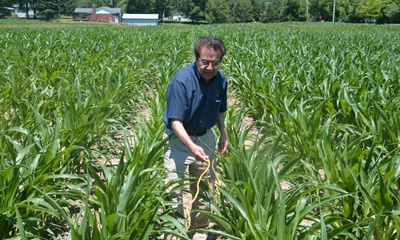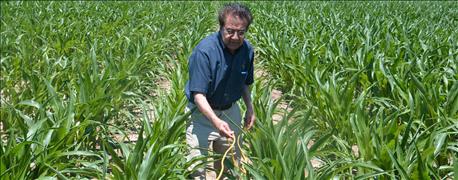
When someone asks Bryan Overstreet how to estimate corn yields in advance of harvest, he refers to a method developed at the University of Illinois years ago. A variation of the formula can be found in the Purdue University Corn & Soybean Field Guide, notes Overstreet, Jasper County Extension ag educator and Indiana Certified Crop Adviser.
It’s a five-step process. Here’s how it works.
Step 1: Measure off 1/1000 acre.

MARK IT OFF: Dave Nanda uses a premarked rope that allows him to measure 1/1000 of an acre at various row widths. He uses it to measure population in the field and then figure yield estimates.
In 30-inch rows, that's 17.4 feet, or 17 feet, 5 inches. Dave Nanda, a crops consultant, actually has a rope marked with the appropriate length for various row widths. He stakes one end and counts ears until he gets to the tape mark on the rope marking the appropriate row width.
Step 2: Count the number of ears in 1/1000 acre.
Nanda typically counts ears in each row on either side of the rope at a given location and then averages the two. For the best results, sample at several locations to come up with an average number of ears per acre.
Step 3: Pull every fifth ear within the testing zone.
Count the number of kernels per ear. The formula in the Purdue guide suggests counting rows of kernels per ear and kernels per row and multiplying those two numbers to get kernels per ear. The steps below also follow the Purdue guide method.
Step 4: Figure average kernels per ear.
Determine the average kernels of all the ears sampled. One option is to find an average for number of rows of kernels and an average for kernels per row based on all ears sampled. Multiply those numbers together.
Step 5: Figure the yield estimate for that site.
Here is the formula from the Purdue guide: Number of ears times average kernels per ear divided by a "fudge factor" equals yield in bushels per acre.
Picking the fudge factor is where it gets tricky. It attempts to account for the fact that kernels vary in size and weight. Typical numbers to plug in are 75, 85 or 95, Overstreet says.
Here are three examples that demonstrate how to use the formula. In this case, the fudge factor is 85.
Example 1: You find 30 ears in 1/1000 acre. The averages are 16.7 rows per ear, and 34 kernels per row. The math: 30 x (16.7 x 34) = 17,034 / 85 = 200.4 bushels per acre
Example 2: You find 30 ears, but average number of rows is 16, and number of kernels per row is 32. The math: 30 x (16 x 32) / 85 = 180.7 bushels per acre
Example 3: You count 34 ears per 1/1000 acre. The average number of rows is 18, and average number of kernels per row is 35. The math: 34 x (18 x 35) / 85 = 252 bushels per acre
About the Author(s)
You May Also Like




